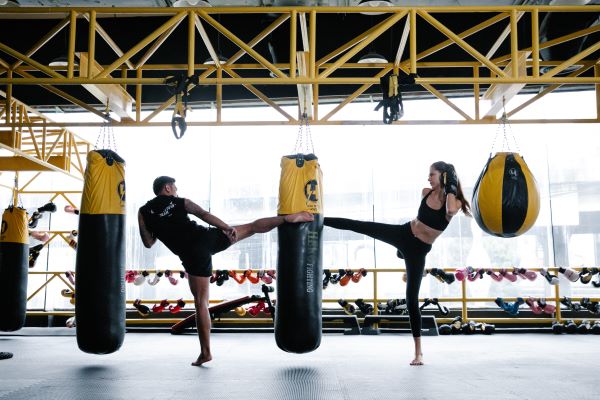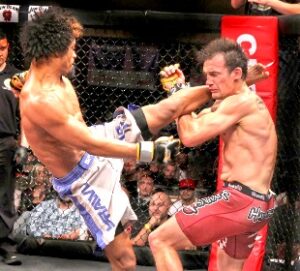
Are you wondering what the differences between Muay Thai and kickboxing are?
In this article, we’ll examine Muay Thai vs kickboxing by going through the 11 key differences between them. We’ll also answer whether you should learn Muay Thai or kickboxing for MMA and which is better for self-defense.
Contents
Muay Thai vs Kickboxing: 11 Key Differences Explained
The key differences between muay Thai and kickboxing are:
- Ways to Attack: Muay Thai uses 8 limbs and includes grappling, while kickboxing uses 6 or 4 limbs depending on the organization/promotion, and doesn’t include grappling.
- Style of Fighting: Muay Thai is kicking-focused whereas kickboxing is boxing-focused.
- Stances: Muay Thai practitioners stand square on with square hips whereas kickboxers stand slightly bladed.
- Main Weapons Used: Muay Thai uses teeps, obliques, knees, and elbows, while kickboxers use question mark kicks, roundhouses, various spinning kicks, and boxing combinations.
- Kickboxing As an Umbrella Term: Muay Thai stands alone, whereas kickboxing’s also referred to as the umbrella term for striking arts which use punches and kicks (which Muay Thai is one).
- Rules: Muay Thai is scored on the whole fight and has 5 three-minute rounds, while kickboxing is scored round by round with the 10-point must system and has varying rounds rules (but usually 3 three-minute rounds).
- Date of Emergence and History: Muay Thai as a combat sport developed in Thailand in the early 20th century, while kickboxing emerged roughly 40 years later in 1960s Japan.
- Age Regulation: Muay Thai fighters compete professionally from a young age to support their families, while kickboxing is heavily regulated and focused on fighter safety.
- Popularity: Muay Thai was only popular in Thailand until ONE Championship took it global, whereas kickboxing has been and is popular on several continents around the world.
- Athlete Earnings: For the most part, kickboxers have much-outearned Muay Thai fighters because of their location and popularity.
- Gloves Used: Muay Thai gloves are designed with grappling in mind and kickboxing gloves with boxing in mind.
Let’s take a closer look at the 11 key differences.
1. Ways to Attack
The first and most glaring difference between muay Thai vs kickboxing is Muay Thai practitioners use 8 limbs to strike: punches, kicks, knees, and elbows. Muay Thai fighters also standing grapple (clinching) and look to strike, control, trip, or sweep their opponent to the ground.
On the other hand, for most of kickboxing’s history, kickboxers only used punches and kicks, but knees are allowed in kickboxing’s biggest promotions and have been since the mid-90s under K-1 rules. Kickboxers aren’t allowed to grapple, trip, or sweep their opponent as it’s striking only.
Overall, this means Muay Thai is much more versatile when it comes to the weapons and defense available. This makes Muay Thai much better than kickboxing for self-defense.
Another smaller difference here is Muay Thai fights are often more bloody (and MMA) than kickboxing fights because elbows are very sharp and can easily slice skin open.
2. Style of Fighting
The Muay Thai style is kicking-heavy and aggressive in terms of power. However, fights start out slow and fighters remain patient as they’re reading their opponent.
They strike less overall but throw kicks with maximum power while using boxing to set up kicks or clinch exchanges. They’re kicking-heavy because kicks score higher than punches in Muay Thai.
Muay Thai fighters look to control the ring and avoid taking a backward step, which sees competitors often firefighting in the center and blocking attacks rather than evading with footwork.
On the other hand, kickboxing is more technical, boxing-heavy, and focused on range control. Kickboxing is fast paced from the get-go and is less about power and more about boxing combinations.
Kickboxers use more feints, head movement, fluid footwork, and circling/in and out movement for evading and setting up their strikes from different angles. Kickboxing is a lot more similar to boxing in this sense because of its boxing-heavy focus.
3. Stances
Closely tied to the style of fighting, the Muay Thai stance has a fighter square on to their opponent with square hips. Their feet are shoulder-width apart with the front foot facing forward and the back leg at a 45-degree angle.
This narrow stance has fighters standing tall and able to fire nontelegraphed kicks from either leg as they can easily lift each leg. They also stand tall as it helps them initiate the Muay Thai clinch and control their opponent with downward pressure.
Their guard is high with the elbows tucked in by their side so they can focus on blocking strikes to the head. Here, they can slightly lower their elbows for blocking strikes to the body. Having the elbows tucked in also helps with balance when throwing kicks.
They remain light on their front leg as this allows them easily lift the leg to kick their opponent and also check kicks when defending.
On the other hand, kickboxers stand in a slightly bladed stance with their body at a roughly 45-degree angle to their opponent. This allows them to put more power in their punches as they can be more easily turned over than from a square stance, and it also reduces the area their opponent can hit.
Kickboxers have their hands around chin height or just under it with their elbows tucked in. This gives them a greater vision to see what their opponent is doing and the ability to use footwork and movement for evading.
It also keeps their body protected where they then use head movement to evade strikes to the head. Kickboxers keep their body and knees slightly bent with more weight on their lead leg as this is better for boxing and movement.
4. Main Weapons Used
Due to the difference in striking limbs and use of grappling in Muay Thai, as well as the different mentality, style of fighting, and stances, Muay Thai vs kickboxing also has different main weapons used.
The main Muay Thai weapons are:
- Elbows and knees both in and out of the clinch
- Calf kicks
- Oblique kicks
- Roundhouse kicks
- Teep kicks
The main kickboxing weapons are:
- Low/high roundhouse kicks
- Calf kicks
- Question mark kicks
- Spinning back/hook kicks
- Boxing combinations mixed in with kicks
- Jabs, hooks, check hooks, shovel hooks, casting punches, crosses, straights, uppercuts, overhands
Essentially, while Muay Thai fighters are kicking-focused, they use less fancy kicks and keep to simple and direct techniques with as much power and precision as possible.
Because of this, they look to connect with the middle part of the shin when kicking, as connecting with the foot at maximum power will likely cause injury.
Kickboxers use more boxing combinations to overwhelm their opponents with great timing, as well as a variety of simple and more flashy kicks as a way to score points and also surprise opponents.
This is required as kickboxers have much better vision, footwork, and movement, and can evade predictable and telegraphed strikes.
Kickboxers connect kicks with any part of the shin and also the foot as they want to reach maximum distance by connecting with the foot. They’re also not always throwing with maximum power and there’s less risk of injury as kickboxers are less check heavy compared to Muay Thai fighters.
5. Kickboxing As an Umbrella Term
Muay Thai is a stand-alone martial art and combat sport which mostly uses the same rules around the world.
New larger promotions such as ONE Championship have made slight changes such as the use of 4 oz gloves rather than the traditional use of 10 oz gloves for entertainment purposes, but mostly there’s consistency.
On the other hand, kickboxing is also the umbrella term for striking martial arts which mostly use punches and kicks and which compete standing. If a fighter’s downed, fighting is stopped until they’re back standing.
As an umbrella term, kickboxing has many martial arts fall under it, such as:
- K-1 Kickboxing (Japanese) – Punches, kicks, and knees are allowed. Elbows, sweeps, and grappling aren’t allowed. Kickboxers can clinch (grapple) if they immediately throw a knee strike.
- American kickboxing – Kickboxers wear trousers and can only punch and kick each other above the waist. Elbows aren’t allowed.
- International Kickboxing – Similar to American kickboxing but also allows low kicks and clinches up to 5 seconds long.
- Dutch kickboxing – Elbow strikes aren’t allowed unless both fighters agree and knees can only strike the body.
- Savate – Only foot kicks are allowed (no shins or knees) and fighters wear trousers, vests, and boots.
- Sanda (Chinese Kickboxing) – Allows throws, sweeps, and takedowns, while knees and elbows are illegal.
- Shootboxing – Allows submissions and throws when standing.
- Muay Thai – Allows knees, elbows, and standing grappling.
Muay Thai is often included as a style of kickboxing, where many styles are separated by different rules and fighting styles.
6. Rules
Round Length
The main difference in rules between Muay Thai and kickboxing is the length of rounds and breaks. Muay Thai is 5 three-minute rounds with a two-minute rest (break) between rounds.
Kickboxing has various different round lengths depending on the promotion and organization regulating an event. Generally though, when referring to kickboxing at the biggest promotions such as Glory, kickboxing has 3 to 5 three-minute rounds with a 1-minute rest between rounds (K-1 rules).
Overall, as mentioned above, Muay Thai is stand-alone and much more consistent with its rules, whereas kickboxing varies because promotions and regulating organizations treat it as an umbrella term.
Scoring
Muay Thai fights are scored as a whole match, rather than round by round. Judges score fighters based on:
- Aggression
- Dominance
- Technical execution
- Total damage inflicted
Kickboxing uses the 10-point scoring system. This is the same system used in boxing and MMA, where judges must give 10 points to the winner of a round and 9 or less to the loser. 10-10 rounds (draws) can be given, but they’re extremely rare in order to prevent fighters coasting.
Judges in kickboxing evaluate fighters based on:
- Number of knockdowns
- Total damage inflicted
- Number of strikes landed
- Aggressiveness and ring control
7. Date of Emergence and History
Muay Thai developed into a combat sport in the early 20th century but has its origins in the 16th-century Siamese army (Thailand was formerly known as Siam) under King Naresuan, where it was learned for warfare.
Muay Thai’s development was heavily influenced by how Western boxing had developed since the 17th century.
Kickboxing developed in the 1950s when a Japanese karateka known as Tatsuo Yamada mixed the rules and fighting styles of kyokushin karate and muay Thai. After trial and error and a few years of kickboxing vs Muay Thai style fights, events labeled kickboxing were born in 1965 in Tokyo.
Overall, the difference between Muay Thai vs kickboxing is Muay Thai has a much deeper history and can be considered a traditional martial art and combat sport, whereas kickboxing is mostly considered only a combat sport.
8. Age Regulation
In Thailand, Muay Thai fighters often start training from around 5 years old and start competing in amateur bouts at the age of 8.
Set in 1999 under the Boxing Act, the minimum age for professional Muay Thai bouts is now 15 years old. However, it’s been criticized as a half-measure, not truly enforced and one that can be easily bypassed by a parent registering their child to compete professionally at an earlier age.
So, before this law was passed, and even in 2023, kids as young as 10 years old are competing professionally as a way to provide for their families.
On the other hand, as per the International Kickboxing Federation (IKF), the sanctioning body for kickboxing in the United States, amateur kickboxers can compete from the ages of 8 to 17, and professionals 18-39. Amateurs can also fight professionally from the age of 16 if they’re good enough.
While there are slight differences depending on the location and kickboxing governing body, they’re all heavily regulated and amateurs have to wear headgear from the ages of 8 to 17, and most can’t fight full contact until 16 years old.
Overall, Muay Thai regulation is very relaxed when it comes to young kids competing in full-contact fights in order to support their families, while kickboxing is heavily regulated by several international and global organizations as fighter safety is the number one priority.
9. Popularity
Muay Thai is the national sport of Thailand, and as most Thais can’t speak fluent English and the rest of the world can’t speak Thai, Muay Thai has been huge in Thailand only.
This has started to change with the arrival of ONE Championship in 2011, which has taken Muay Thai global alongside MMA, kickboxing, and submission grappling.
On the other hand, since the 1950s, kickboxing has grown popular in many different locations. In Asia: Japan and China, in Europe: Netherlands, France, and the UK (and other countries), in North America: America and Canada, and in South America: Brazil.
For this reason, kickboxing is a more popular combat sport than Muay Thai because it was adopted around the globe, with each region implementing its own spin and slightly different rules.
10. Athlete Earnings
Professional Muay Thai fighters earn roughly 10,000 to 15,000 baht per fight on average, which is $291 to $436 (£234 to £351) as of May 2023.
It’s easy to see why many families want their young children to become professional Muay Thai fighters when the average monthly salary for a Thai is around 15,000 baht.
On the other hand, professional kickboxers earn roughly between $500 to $3,000 per fight on average.
However, with the popularity of many high-level kickboxing promotions compared to Muay Thai, kickboxers have the opportunity to earn up to $30,000 per fight, and a lot more for the most elite fighters and champions.
Across both combat sports, the most elite Muay Thai fighters and kickboxers who get into promotions like ONE Championship can earn hundreds of thousands of dollars per fight.
11. Gloves Used
Muay Thai gloves are slightly different to accommodate the grappling aspect of combat.
They have slightly more space inside the glove, no mesh across the palm, more evenly distributed padding, shorter wrist cuffs, a more moveable thumb, and easier opening and closing of the palm, all to allow fighters to catch leg kicks and grab and initiate the Muay Thai clinch.
The Muay Thai gloves have more padding on the sides and top of the glove (less on the knuckles) because this also helps with absorbing impact when blocking strikes and because Muay Thai fighters box less.
With the focus on punching combinations, kickboxing gloves have the thumb kept close to the fist, the fingers more naturally curved toward the shape of a clenched fist, and longer wrist cuffs with more padding for improved wrist support to minimize injury.
In terms of ring attire, the only real difference between kickboxing and Muay Thai is the Muay Thai fighters wear Pra Jiads (armbands) when fighting. Pra Jiads are symbols of good luck which were originally given by family members to Thai warriors before entering the battlefield.
Should You Learn Muay Thai or Kickboxing for MMA?
For the majority of people and especially beginners, Muay Thai should be the primary martial art choice for MMA because everything it teaches is applicable to MMA.
Practitioners learn how to strike with all 8 limbs and how to standing- grapple/clinch. In the clinch, they’ll be able to strike their opponent, control them, and trip/sweep them to the ground which is where Brazilian jiu-jitsu takes over.
However, kickboxing cab be equally effective for MMA as practitioners become skilled with knees, kicks, and especially boxing – and boxing is the main weapon used in MMA.
Kickboxing’s focus on footwork, movement, and fluidity is also more applicable to MMA as fighters who stand too stationary find it hard to become title contenders as they’re easily taken down (wrestled) or picked apart at range by elite strikers. Movement, feinting, and footwork are key to success in MMA.
Overall, both Muay Thai and kickboxing are great for MMA. They teach many of the same skills but also have useful differences. At the end of the day, both are very effective but are just one of the several martial arts needed for MMA. MMA fighters also need to learn wrestling and Bjj to further round out their skills.
Which Is Better: Muay Thai or Kickboxing for Self-Defense?
Muay Thai is conclusively better than kickboxing for self-defense for the following reasons.
- Muay Thai teaches how to strike with 8 limbs: punches, kicks, knees, and elbows, whereas kickboxing only uses punches, kicks, and knees.
- Muay Thai teaches how to standing-grapple whereas kickboxing doesn’t. Standing grappling is essential as most aggressors look to grab, and Muay Thai practitioners can strike in the clinch, defend takedowns, grip fight to push an aggressor away, control them, or take them down via trips and sweeps.
- Muay Thai practitioners often use useful defensive techniques such as the teep kick and oblique kick.
- Muay Thais focus on how to check kicks and block strikes, as well as how to evade.
Overall, Muay Thai is better than kickboxing for self-defense because it was born for warfare and therefore much more applicable to real-life self-defense situations. It’s defensively sound, applicable at all ranges, has more striking variety, and most importantly it includes grappling.
Kickboxing, while an elite striking martial art, doesn’t have any grappling which is the key skill in self-defense situations. Until someone has been grabbed, they can escape an attack by simply running.




